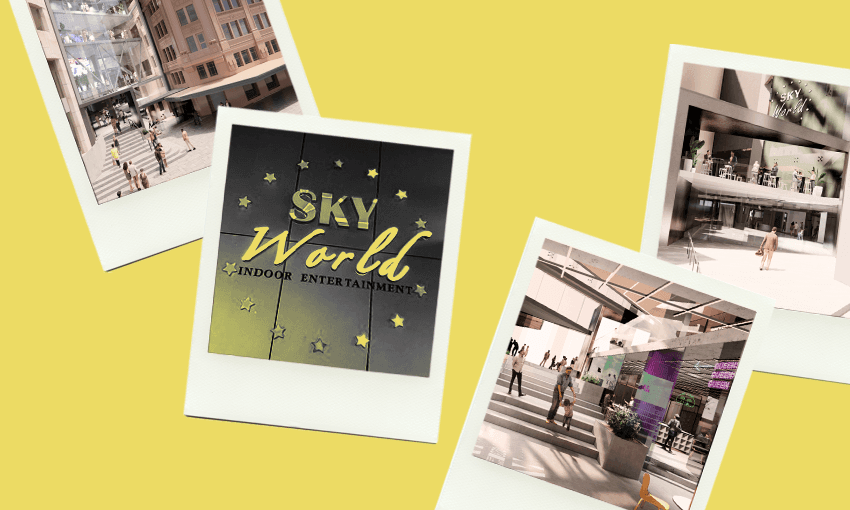An architect explains his vision for a rundown entertainment complex in the middle of Auckland. (Yes, the rocket ship elevator is staying put.)
An entire food court worth of tenants has vacated the premises. Oil is leaking and pooling on the edges of escalators. A digital movie display offers up films — Jojo Rabbit and Rise of Skywalker — from 2019. A floor once full of restaurants is locked up. You can’t get a burger, or a beer. The carpet is exactly the same.
First opened 22 years ago, Auckland’s Skyworld building has been due a makeover for at least half that time. Right now, a visit to 291-297 Queen Street will bring not joy but frowns, with broken walls, blown bulbs and a depressingly gloomy vibe best encapsulated by a comment from a visiting Whangarei resident: “What happened here?”
Tenants from the building’s peak, like Borders, Starbucks, Planet Hollywood and Burger King, are long gone, with just an Event Cinemas movie theatre (including a giant iMax screen), the GameOn video arcade, Metrolanes bowling and the Odyssey Sensory maze left standing. Faded posters pinned to the outside promise “something awesome is coming” but they’ve kept us in suspense for at least five years.
Changes, however, are afoot. Skyworld appears ready to rise again. Renovation plans are underway, and a major local architectural firm has produced a 48-page vision. It shows a re-imagined front entrance that removes the current slippery stairs and replaces them with something much more modern, open and inviting.
Around the back, the Bledisloe Lane entrance has also been made over, ready to make the most of crowds arriving once the City Rail Link is complete. A station will be open just around the corner, delivering people to shops, restaurants, apartments and university. “It’s going to bring a hell of a lot more people into that location,” says lead architect Gareth Huston, from the firm Warren and Mahoney.
Huston’s proposal pivots Skyworld’s Queen Street entrance to utilise the former cylindrical Starbucks centre, while carefully incorporating a neighbouring heritage building. “The current entry is that bulbous, ugly piece of architecture,” he says. “We’re going to clean all that up – this facade will sit lightly on it. It will make a dramatic difference … there’s no two ways about it.”
Inside, some things are staying put. Huston describes his design as “raw … we’re not trying to pretty it up at all”. Yes, the original, much-loved rocket ship elevator will stay, and may even be spruced up. The elevators and sky paths will also remain, but Huston says he’s worked hard to make the building far more accessible, with more signs and accessways.
That means improvements being made to the circular interior spiral staircase, the place everyone seems to get lost using. “It’s a pretty confusing building once you’re in there,” he says.
Huston rightly believes Skyworld’s makeover is long overdue. “It’s sad to see the state it’s in now,” he says. “This is a building that, when it first came to life, helped that end of Queen Street become the entertainment centre.” He’s hoping his plans can help do that again, providing competition for patronage and tenants from the newer parts of town, like Wynyard Quarter and Commercial Bay.
Construction will take a year, but can’t start until resource consent is approved by Auckland Council. “We’re pretty comfortable it will go through,” says Huston, who anticipates it should take just a few more weeks. After that, a construction contract will go out for tender, but some interior work has already been carried out, sealing off the old food court area, and opening up the interior pass.
This is by no means the first Skyworld renovation plan. Previous iterations included giant wraparound digital displays and a floating bar, while the building’s original architect Ashley Allen floated the idea of rooftop dining and concerts, an outdoor elevator capable of taking 50 people to the rooftop at a time, and a giant cigar shaped structure being installed on the rooftop.
Huston says his idea is a more simple concept that pays tributes to the building’s previous design as a “Bladerunner-esque” vision that people can get lost in. “Aotea [Square] is a great civic space in the city,” he says. “Anything adjacent to that, affecting that, should have the attention that other areas are getting.”
A spokesperson for James Kwak, the director of J&J Holdings, the building’s owner, didn’t respond to a request for comment.



